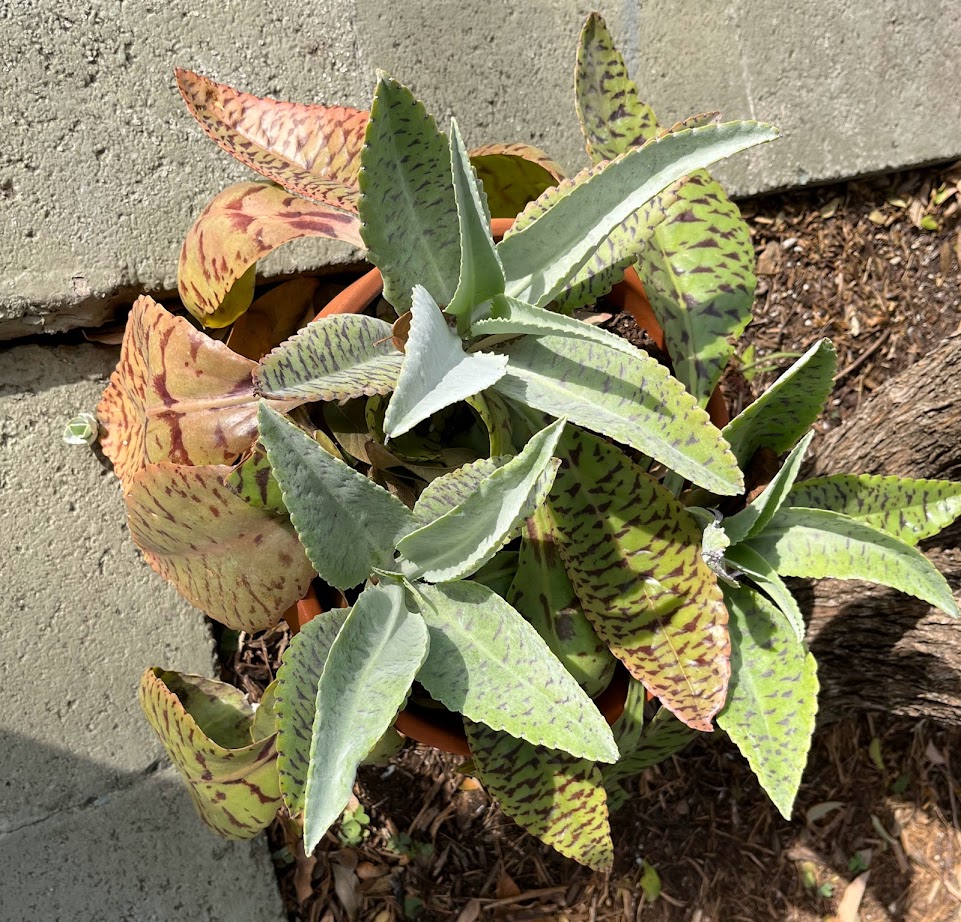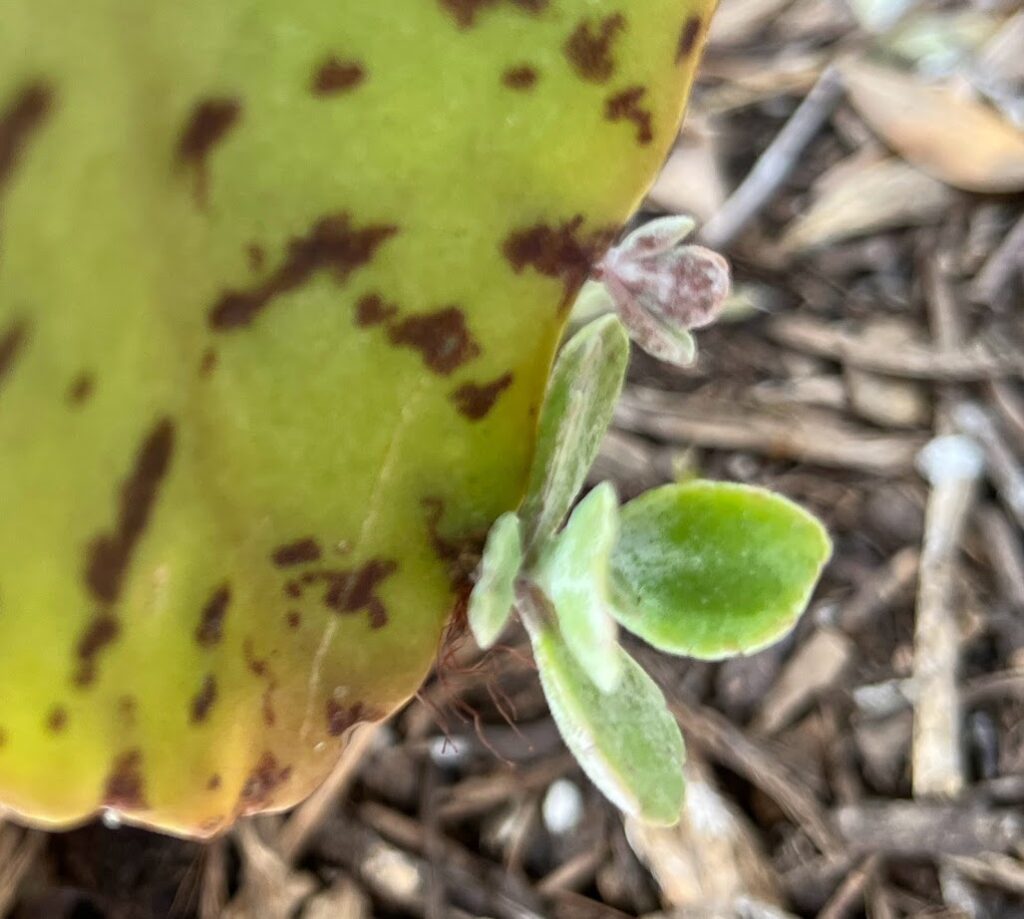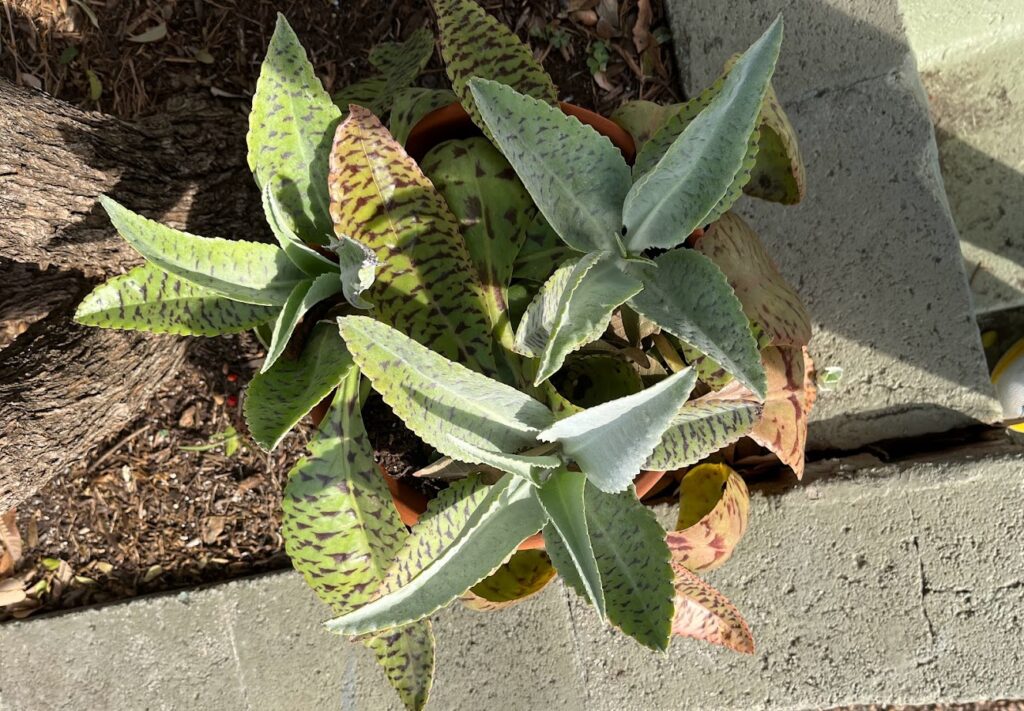By Marsha Krassner, Bexar County Master Gardener
February 2023

I readily admit that I have a penchant for unusual-looking plants. So, when I spotted one that I’d never seen before, I was immediately captivated and took it home with me!
The Donkey Ear plant is a fast-growing succulent known for its quirky foliage and leaves that resemble the ears of a donkey. The leaves are waxy-coated and maroon-splotched and can grow up to 20” long. Plantlets grow at the tips, which either drop to the ground, or weigh the main leaf down (in my case) so that they take root and develop a new baby plant.
The Donkey Ear is native to Madagascar and is happiest when growing in subtropical, Mediterranean, or desert-type climates. San Antonio’s weather seems to fit the bill, and I have enjoyed watching this plant thrive in my garden.
The botanical name (Kalanchoe gastonis-bonnieri) has an interesting backstory. Many believe that the word “Kalanchoe” is derived from the Chinese word “Kalan Chauhuy,” which means “what falls and grows.” Certainly, in my experience, I regularly see the leaves growing quickly and drooping over the pot, with small red and yellow plantlets at the ends.
The second part of the name honors a well-known French botanist, Dr. Gaston Bonnier.
Other nicknames for this plant include Palm Beachbells, Sprout Leaf Plant, Leaf of Life, and Tree of Life.
CARING FOR YOUR DONKEY EAR PLANT
WATERING & FERTILIZING NEEDS Donkey Ear plants are drought resistant so they can tolerate under-watering. You can typically expect to water your Donkey Ear Plant once a week. In the warmer months of spring and summer, these succulents will need more frequent watering, while in autumn and winter less watering is needed.
I water my Donkey Ear Plant only when the top 1 or 2 inches of soil start to dry out. To check the moisture, I gently press my finger into the top layer of the plant’s soil. If I still feel moisture, it is not ready to be watered. But, if the soil is dry to the touch, it’s time!

The best method I have found for watering this exotic, beautiful plant is the “deep and thorough” method: slowly water the Donkey Ear until water begins to drip out of the bottom. My plant is in a clay pot with drainage holes so that excess water has an escape route, leaving it in well-moistened soil that is not soggy. In short, I never leave my Donkey Ear sitting in a puddle of water.
Plant experts recommend feeding the Donkey Ear Plant twice a week in summer using a liquid fertilizer or a slow-release fertilizer.
LIGHT NEEDS Donkey Ear Plants love the sun. They grow best with a good amount of exposure to the sun every day. Although these plants like the sun, extended periods of direct sun exposure can be harmful to the succulent’s foliage, and I have read that the plant could suffer from sun scorch.
While many plant experts say that a minimum of six hours of sun exposure is recommended, my Donkey Ear seems happy with its location: under a Texas Mountain Laurel where it receives filtered sun to partial shade during the day.
SOIL NEEDS As a succulent, the Donkey Ear Plant needs to be kept in a light, well-draining soil mix. The recommended soil pH level for Donkey Ear Plants is between 5.0 and 7.0.

When I brought my Donkey Ear Plant home, I placed it in a terra cotta pot with an all-purpose potting mix, which seems to be working just fine. At some point, I will need to re-pot it, and I will most likely continue to use an all-purpose soil mix containing sand, loam, and pumice.
COMMON PROBLEMS WITH DONKEY EAR PLANTS Thus far, I have had no problems with my Donkey Ear plant. Nonetheless, these succulents can be affected by crown rot, powdery mildew, aphids, spider mites, and mealybugs. While these pests are not life-threatening, they can be annoying.
In the event that your Donkey Ear Plant has a pest problem, the solution is to gently wipe the plant’s leaves with a slightly damp cloth. If the problem is severe, you should wipe your plant’s foliage with a cotton swap and apply neem oil.
A note of caution: The Donkey Ear plant can cause toxic side effects if ingested in large amounts. It is harmful to humans and animals so you should keep it away from pets and children.
In short, Donkey Ear plants are a great addition to anyone’s garden. They are low-maintenance, drought-tolerant, and easy to please. Enjoy!
All photos by Author
